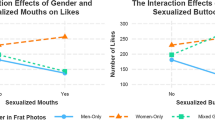Abstract
This article reports the results of a content analysis of sexual rhetoric in editorial photographs (N=994) in 2001 issues of Maxim and Stuff magazines. Goffman’s (1979) classifications of gender in advertisements were used to examine how this new generation of “lad” magazines uses images to provide readers with cues about sexuality and sexual practice. The findings reveal that both magazines construct sexuality in similar ways. However, as expected, the overall message about sexuality in the photos is different for men than for women. Women are more likely than men to be portrayed as sex objects, such as the common practice of photographing them in contorting or demeaning positions. Both magazines also depict white people as sexier than other races and assume heterosexuality.
Similar content being viewed by others
References
Barron, M., & Kimmel, M. (2000). Sexual violence in three pornographic media: Toward a sociological explanation. Journal of Sex Research, 37, 161–169.
Bird, S.R. (1996). Welcome to the men’s club: homosociality and the maintenance of hegemonic masculinity. Gender and Society, 10, 120–132.
Bissell, K.L. (2002). I want to be thin, like you. News Photographer, 57, 4–12.
Bogaert, A.F., & Turkovich, D.A., & Hafer, C.L. (1993). A content analysis of Playboy centerfolds from 1953–1990: Changes in explicitness, objectification and model’s age. Journal of Sex Research, 20, 135–139.
Bordo, S. (1999). The Male Body: A New Look at Men in Public and in Private. New York: Farrar, Strauss, and Giroux.
Bordo, S. (1993). Unbearable Weight: Feminism, Western Culture, and the Body. Berkeley: University of California Press.
Brannigan, A., & Goldenberg, S. (1987). The study of aggressive pornography: The vicissitudes of relevance. Critical Studies in Mass Communication 4, 262–263.
Courtney, A., & Lockeretz, S. (1971). A woman’s place: an analysis of the roles portrayed by women in magazine advertisements. Journal of Marketing Research, 8, 92–95.
Courtney, A., & Whipple T. (1983). Sex Stereotyping in Advertising. Lexington: D.C. Health.
Ferguson, J.H., Kreshel, P.J., & Tinkham, S.F. (1990). In the pages of Ms.: Sex Role Portrayals of women in advertising. Journal of Advertising, 19, 40–51.
Fisher, W.A., & Grenier, G. (1994). Violent pornography, anti-woman thoughts, and anti-woman acts: In search of reliable effects. The Journal of Sex Research, 31, 23–38.
Foucault, M. (1979). Discipline and Punish. New York: Vintage.
Gabriel, J. (1998). Whitewash: Radicalized Politics and the Media. London: Routledge.
Goffman, E. (1979). Gender Advertisements. Cambridge: Harvard University Press.
Harrison, K. (2000). The body electric: Thin-ideal media and eating disorders in adolescents. Journal of Communication, 50, 119–143.
Hyde, J.S., & Jaffee, S.R. (2000). Becoming a heterosexual adult: The experiences of young women. Journal of Social Issues, 56, 283–297.
Itzkoff, D. (2002, June 5). Lad no more: my escape from maxim. New York Press. Retrieved 3/3/03 from the World Wide Web: http://www.nypress.com/ 15/23/news&columns/feature.cfm
Jackson, P. (1994). Black male: advertising and the cultural politics of masculinity. Gender, Place, and Culture: A Journal of Feminist Geography, 1, 49–60.
Kang, M. (1997). The portrayal of women’s images in magazine advertisements: Goffman’s gender analysis revisited. Sex Roles: A Journal of Research, 37, 979–997.
Klassen, M. L., & Jasper, C. R., & Schwartz, A.M. (1993). Men and women: Images of their relationships in magazines and advertisements. Journal of Advertising Research, 33, 30–40.
Krassas, N.R., Blauwkamp, J.M., & Wesselink, P. (2001). Boxing Helena and Corseting Eunice: Sexual Rhetoric in Cosmopolitan and Playboy Magazines. Sex Roles: A Journal of Research, 44, 1–21.
Kuhn, A. (1985). The Power of Image: Essays on Representation and Sexuality. London: Routledge.
Lambiase J. & Reichert T. (2003). Is there a maxim effect? Men’s magazines covers “sexed-up” for sales. Unpublished Manuscript.
Linz, D. (1989). Exposure to sexually explicit materials and attitudes toward rape. The Journal of Sex Research, 26, 50–84.
Malkin, A.R., Wornian, K., & Chrisler, J.C. (1999). Women and weight: Gendered messages on magazine covers. Sex Roles: A Journal of Research, 40, 647–656.
Mason, G. (1992). Looking unto masculinity: sport, media and the construction of the male body beautiful. Social Alternatives, 11, 27–32.
Mayerson, S.E., & Taylor, D.A. (1987). The effects of rape myth pornography on women’s attitudes and the mediating role of sex role stereotyping. Sex Roles: A Journal of Research, 1987, 321–338.
Pingree, S., & Hawkins, R., & Butler, M., & Paisley, W. (1976). A scale for sexism. Journal of Communication, 24, 193–200.
Pipher, M. (1994). Reviving, Ophelia: Saving the Selves of Adolescent Girls. New York: Ballantine Books.
Rich, M.K., & Cash, T.F. (1993). The American image of beauty: Media representations of hair color for four decades. Sex Roles: A Journal of Research, 29, 113–125.
Rohlinger, Deana A. (2002). Eroticizing men: Cultural influences of advertising and male objectification. Sex Roles: A Journal of Research, 46, 61–74.
Ruggiero, J.A., & Weston, L.C. (1985). Work Options for women in women’s magazines: The medium and the message. Sex Roles: A Journal of Research, 12, 535–547.
Sexton D.E., & Haberman P. (1974). Women in magazine advertisements. Journal of Advertising Research 14, 41–46.
Smith, D.D. (1976). The social content of pornography. Journal of Communication, 26, 16–24.
Soley, L., & Kurzbard, G. (1986). Sex in advertising: A comparison of 1964 and 1984 magazine advertisements. Journal of Advertising, 15, 46–54.
Sullivan, G. L., & O’Connor, P.J. (1988). Women’s role protrayals in magazine advertising 1958–1983. Sex Roles: A Journal of Research, 18, 181–189.
Thomas, M.E., & Treiber, L. A. (2000). Race, Gender, and Status: A Content Analysis of Print Advertisements in Four Popular Magazines. Sociological Spectrum, 20, 357–371.
Venkatesan, M., & Losco, J. (1975). Women in magazine ads: 1959–1971. Journal of Advertising Research, 15, 49–54.
Vigorito, A.J., & Curry, T.J. (1998). Marketing masculinity: Gender identity and popular magazines. Sex Roles: A Journal of Research, 39, 135–153.
Author information
Authors and Affiliations
Rights and permissions
About this article
Cite this article
Krassas, N.R., Blauwkamp, J.M. & Wesselink, P. “Master your Johnson”: Sexual rhetoric in Maxim and Stuff magazines. Sex Cult 7, 98–119 (2003). https://doi.org/10.1007/s12119-003-1005-7
Issue Date:
DOI: https://doi.org/10.1007/s12119-003-1005-7




